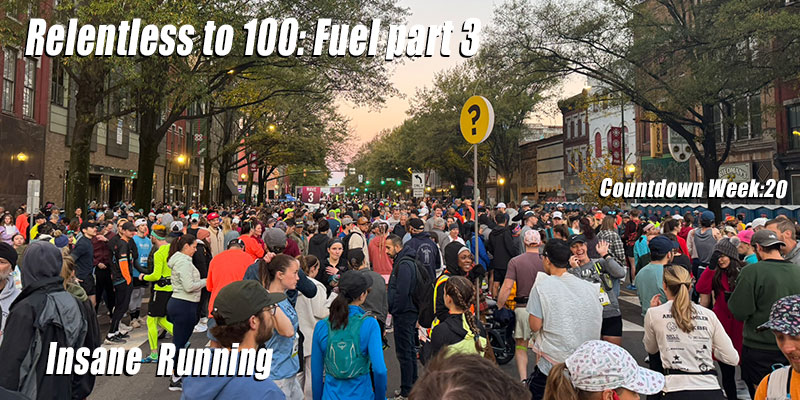Relentless to 100: Week 20
As we have discussed in earlier posts, a 100 mile in under 24 hours is a very demanding event that pushes the limits of physical and mental endurance. It is crucial to understand the calories burned during long-distance running and, because everyone is unique, how your body consumes fuel throughout the race.
This is part of a series of posts regarding how we prepare, plan, and train to complete the 100 miles Ultramarathon Umstead 100: Relentless to 100. For all the ultrarunning series, here is Relentless to 100, last week’s post, and for additional ideas, follow the link. Training for a 100.
The number of calories burned during ultrarunning varies based on factors such as your weight, pace/effort, and terrain. On average, a runner burns between 100 and 110 calories per mile, but this can increase significantly during challenging courses or adverse weather conditions and running efficiency. For example, running uphill requires more energy than running on a flat surface, leading to a higher caloric expenditure.
Your body relies primarily on carbohydrates and fats for fuel. Your body can hold about 1,600 to 1,700 calories when those storage are fully replenished. Hence, there will be “carb” loading in the upcoming days prior to the event.
SIDE NOTE: You might have already experienced or heard about Hitting the wall/Bonking. With no fueling or improper fueling strategy, this starts happening to runners starting around mile 17 when the 1,600 to 1,700 are almost depleted.
Protein is sometimes processed by the body for energy, but you really want to minimize this as the fuel from protein comes from muscle mass. The same muscle mass that could be propelling you forward. At very low intensities/effort, your body primarily burns fat effectively to supply the necessary energy. However, as the intensity increases, such as during intense uphill sections or higher pace/efforts, your body shifts to using mostly carbohydrates, which are stored in the form of glycogen in your muscles and liver.
Diabetes note: Now, one additional thing that we have to keep in mind is not only the calories but where those calories are coming from. What kind of carbs are we consuming, low or high glycemic index fuel? The reason we need to keep an eye on those is that depending on the amount of effort we are doing as well as the intake your sugars are going to affect and make your sugars fluctuate differently. We have to always keep that in mind, as we can’t just disregard the trending element of yo0u glucose levels as well as the monitoring of you insulin intake.
Assessment:
Let’s do some simple calculations. If we are running a 100-mile event and we burn, on average, 100-110 calories, at a minimum, we will be burning around 10,000 to 11,000 calories. Since we can store around 1,700 calories at the start, that will leave you with a caloric deficit of roughly 8,800.
Alright, you do not need to use 88 100-calorie gels in a 100-mile event. Roughly a gel 1.1 miles, would be a recipe for a stomach disaster. Fortunately, we still have the energy from fat. This could be in the range of 30% up to 50% of the calories consumed by every mile, depending on your fat adaptation (the efficiency of your body to use fat)
Now, for some more numbers for you, out of the 8,800 calories, we could have the body using fat to cover roughly 3,500 calories, leaving you with only a 5,300 caloric deficit to cover. Fifty-three gels sound better than 88. Yes, but remember last week’s initial homework? A,B,C & N lists anyone?
Keep also in mind that you have extra calories available for you with the secondary items, extra fuel items, and whatever is available to you at the aid stations.
Here, you might use a combination plan like the following,
1,900 calories from liquid fuel, (Tailwind, E-Fuel, U-Can, Juice)
1,400 calories from gels, (GUs, Cliff, Mautern, Spring Energy, Huma Gel, Baby Food pouches)
1,200 calories from solid fuel, (PowerBar, gummies, Maurten solid, Cliff Bar, Larabars)
800 calories from other, (Soup, sandwich, clementine, cookies, chips, quesadilla)
Planning:
Pre-Race Nutrition: You need to ensure you start the race with optimal glycogen stores by consuming a balanced meal rich in carbohydrates the night before. This can include pasta, rice, or other complex carbohydrates. Also, on the morning of the training run or the event, grab some carbs in preparation to top the last available storage. Plan accordingly.
Pre-Start Nutrition: A general guideline often used is that the stomach can hold approximately 500 to 700 calories during a typical meal. Listen, not that you are going to have a meal at the start of the event, but strategically, if you can eat 100-200 calories just prior to the start, you will be starting with 100 that will be digesting during the 1st few miles of the event to cover the total calories for the event. Plan and test accordingly.
During the Race: Depending on the course, aid stations, and elevation change, you need to plan how you are going to consume those calories that are going to help you to have a great event. Plan to consume a mix of carbohydrates and electrolytes during the race to maintain energy levels. Those great items from the lists that you have been gathering and testing during the training runs are your source of information and planning. Plan and test accordingly.
When to use? Some runners use time, for example, every 30 minutes or 35 minutes. Others use miles, like every 3 or 4 miles. Another option is course cues, for example, at the water fountains, aid stations, creek crossing, big tree formation, and/or specific hill (Cemetery Hill at Umstead Park), I like to use a combination of miles and landmarks alongside the course. Distribute the total calories that best fit the efforts, stomach, and goals.
This week’s actual numbers:
| Week 20 | Mon | Tue | Wed | Thur | Fri | Sat | Sun | Total |
| Plan | Stretches & Rolling | 5 | 5 | 6 | Rest | 26 | Rest | 42 |
| Actual | Stretches | 4 | 5 | Stretches & Rolling | 4 | 29 | Rest | 42 |
Next Week Plan:
| Week 19 | Mon | Tue | Wed | Thur | Fri | Sat | Sun | Total |
| Plan | Stretches & Rolling | 5 | 5 | 3 | Rest | 15 | 18 | 46 |




